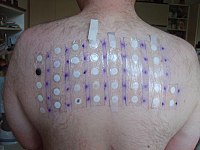
Diacetone alcohol decomposition and benzaldehyde Cannizzaro reaction as test reactions for the basic strength measurements of alumina, magnesia, Amberlyst type resins (A-15, XN 1010, A-26, A-21), Nafion NR 50 and solid sulfuric acid
Sign Up to like & getrecommendations! Published in 2018 at "Reaction Kinetics, Mechanisms and Catalysis"
DOI: 10.1007/s11144-018-1492-z
Abstract: The decomposition of diacetone alcohol to acetone proceeding at 303 K as well as the Cannizzaro transformation of benzaldehyde at 323 K leading to benzyl alcohol, can be regarded as useful test reactions in investigating the basic… read more here.
Keywords: strength; diacetone alcohol; basic strength; amberlyst ... See more keywords

Dermoscopy of patch test reactions: study of applicability in differential diagnosis between allergic and irritant reactions
Sign Up to like & getrecommendations! Published in 2019 at "British Journal of Dermatology"
DOI: 10.1111/bjd.17389
Abstract: Correct interpretation of patch test reactions is of paramount importance for differentiating allergic from irritant contact dermatitis (ICD). Differentiating weak positive and/or doubtful allergic patch test reactions from irritant reactions can be difficult. The aim… read more here.
Keywords: patch test; test reactions; irritant reactions; allergic irritant ... See more keywords

Gene profiling reveals a contact allergy signature in most positive Amerchol L‐101 patch test reactions
Sign Up to like & getrecommendations! Published in 2022 at "Contact Dermatitis"
DOI: 10.1111/cod.14077
Abstract: Diagnosis of contact allergy (CA) to Amerchol L‐101 (AL‐101), a marker for lanolin allergy, is problematic. Positive patch test reactions are frequently doubtful or weakly positive and difficult to associate with clinical relevance. read more here.
Keywords: contact; contact allergy; test reactions; amerchol 101 ... See more keywords

Thoughts on the interpretation of positive photopatch test reactions
Sign Up to like & getrecommendations! Published in 2020 at "European Journal of Dermatology"
DOI: 10.1684/ejd.2020.3877
Abstract: Positive photopatch test reactions are classified according to the International Contact Dermatitis Group. The various reaction patterns are interpreted to represent patterns such as contact allergy, photocontact allergy, photoaugmentation, and photoinhibition. To investigate whether there… read more here.
Keywords: contact; photopatch; photopatch test; test reactions ... See more keywords